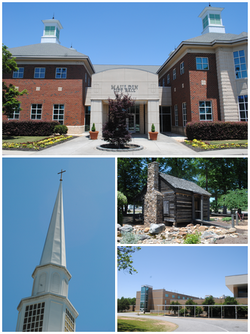Mauldin | |
|---|---|
 Top, left to right: Mauldin City Hall, Mauldin Methodist Church, Mauldin Cultural Center, Mauldin High School | |
| Motto: "Explore Our Thriving Community" | |
 Location in South Carolina | |
| Coordinates: 34°46′51″N82°18′2″W / 34.78083°N 82.30056°W | |
| Country | United States |
| State | South Carolina |
| County | Greenville |
| Founded | 1784 |
| Chartered (town) | December 24, 1890 [1] |
| Chartered (city) | 1969 [2] |
| Named after | William L. Mauldin |
| Area | |
• Total | 12.13 sq mi (31.42 km2) |
| • Land | 12.07 sq mi (31.26 km2) |
| • Water | 0.06 sq mi (0.17 km2) 0.49% |
| Elevation | 942 ft (287 m) |
| Population | |
• Total | 24,724 |
• Estimate (2023) | 28,010 |
| • Density | 2,048.72/sq mi (791.00/km2) |
| • Urban | 159,506 (US: 227th) [6] |
| • Urban density | 1,576.1/sq mi (608.5/km2) |
| Time zone | UTC−5 (Eastern (EST)) |
| • Summer (DST) | UTC−4 (EDT) |
| ZIP code | 29662 |
| Area codes | 864, 821 |
| FIPS code | 45-45115 [7] |
| GNIS feature ID | 1246563 [4] |
| Website | www |
Mauldin is a city in Greenville County, South Carolina, United States. The population was 24,724 at the 2020 census, making it the 19th-most populous city in South Carolina. [8] It is located in the Greenville-Anderson-Greer, SC Metropolitan Statistical Area. [9]


